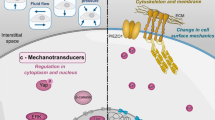Abstract
Throughout development cells make the decision to proliferate, arrest or die. Control of this process is essential for normal development, with unrestrained cell proliferation and cell death underling the origin and progression of disease. The cell-cycle is tightly regulated by a number of factors including the cyclin-dependent kinase inhibitor 1A (Cdkn1a), termed p21 (or Cip1 or WAF1). p21 acts as a negative regulator of cell-cycle progression by binding and inhibiting complexes formed between the cyclin-dependent kinases and their catalytic partners the cyclins. In this report we identify the temporal spatial expression profile of p21 in the developing mid-term mouse embryo using a p21-LacZ reporter mouse line. Expression of p21 was restricted to specific regions with a correspondence to both areas of terminal differentiation and active remodelling. A complex temporal and spatial relationship between p21 expression and regions of apoptosis was evident. A protective role with regard to apoptosis for p21 is proposed.



Similar content being viewed by others
References
Boulaire J, Fotedar A, Fotedar A, Fotedar R (2000) The functions of the cdk-cyclin kinase inhibitor p21WAF1. Pathol Biol (Paris) 48.3:190–202
Buckingham M (2001) Skeletal muscle formation in vertebrates. Curr Opin Genet Dev 11(4):440–448
Capocefalo A et al (2009) p21(Waf1/Cip1) as a molecular sensor for BoHV-4 replication. J Virol Methods 161(2):308–311
Cecconi F, Gruss P (2001) Apaf1 in developmental apoptosis and cancer: how many ways to die? Cell Mol Life Sci 58(11):1688–1697
Cinnamon Y, Kahane N, Kalcheim C (1999) Characterization of the early development of specific hypaxial muscles from the ventrolateral myotome. Development 126(19):4305–4315
Dietrich S et al (1998) Specification of the hypaxial musculature. Development 125(12):2235–2249
Donner AJ et al (2007) Stimulus-specific transcriptional regulation within the p53 network. Cell Cycle 6(21):2594–2598
Fallon JF, Saunders JW Jr (1968) In vitro analysis of the control of cell death in a zone of prospective necrosis from the chick wing bud. Dev Biol 18(6):553–570
Gartel AL (2006) Inducer and inhibitor: “antagonistic duality of p21 in differentiation.”. Leuk Res 30(10):1215–1216
Gartel AL, Tyner AL (2002) The role of the cyclin-dependent kinase inhibitor p21 in apoptosis. Mol Cancer Ther 1(8):639–649
Gong S et al (2003) A gene expression atlas of the central nervous system based on bacterial artificial chromosomes. Nature 425(6961):917–925
Macleod KF et al (1995) p53-dependent and independent expression of p21 during cell growth, differentiation, and DNA damage. Genes Dev 9(8):935–944
Parker SB et al (1995) p53-independent expression of p21Cip1 in muscle and other terminally differentiating cells. Science 267(5200):1024–1027
Saunders JW Jr (1966) Death in embryonic systems. Science 154(749):604–612
Sharpe J et al (2002) Optical projection tomography as a tool for 3D microscopy and gene expression studies. Science 296(5567):541–545
Sporle R (2001) Epaxial-adaxial-hypaxial regionalisation of the vertebrate somite: evidence for a somitic organiser and a mirror-image duplication. Dev Genes Evol 211(4):198–217
van Kleffens M et al (1998) mRNA expression patterns of the IGF system during mouse limb bud development, determined by whole mount in situ hybridization. Mol Cell Endocrinol 138(1–2):151–161
Vasey DB et al (2008) p21-LacZ reporter mice reflect p53-dependent toxic insult. Toxicol Appl Pharmacol 227(3):440–450
Zuzarte-Luis V, Hurle JM (2005) Programmed cell death in the embryonic vertebrate limb. Semin Cell Dev Biol 16(2):261–269
Acknowledgments
We are grateful to the animal care staff for their assistance in this project. This work was funded by the BBSRC through a CASE award with CXR Biosciences LTD to DV and ISPG support to CBAW.
Author information
Authors and Affiliations
Corresponding author
Electronic supplementary material
Below is the link to the electronic supplementary material.
11248_2010_9385_MOESM1_ESM.tif
Supplementary Fig. 1 LacZ staining in p21-LacZ and non transgenic 14.5 dpc embryos. LacZ staining was carried out on 14.5 dpc embryos of p21-LacZ and non transgenic CBA/C57BL/6 genetic background. Staining was detected in various regions of the p21-LacZ embryo while no staining was detected in the non transgenic embryo, n = 3 (TIFF 539 kb)
Supplemental Video S2 (MPG 4322 kb)
Supplemental Video S4 (MPG 3748 kb)
Supplemental Video S6 (MPG 4136 kb)
Rights and permissions
About this article
Cite this article
Vasey, D.B., Roland Wolf, C., Brown, K. et al. Spatial p21 expression profile in the mid-term mouse embryo. Transgenic Res 20, 23–28 (2011). https://doi.org/10.1007/s11248-010-9385-6
Received:
Accepted:
Published:
Issue Date:
DOI: https://doi.org/10.1007/s11248-010-9385-6




